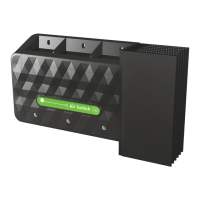
Do you have a question about the Best.Energy Eniscope Hybrid and is the answer not in the manual?
| humidity | 0 - 80% (non condensing) |
|---|---|
| meter operating temperature | 10°C to 40°C nominal |
| storage temperature | 0°C to 50°C nominal |
| altitude | 2000m above sea level maximum |
| aux supply voltage | 100 – 240V~ 50/60 Hz |
|---|---|
| power consumption | < 20W |
| current | 20mA |
| nominal full scale voltage | 346V~LN/600V~LL |
|---|---|
| withstand voltage | 1000V~ LN & LL |
| input impedance | > 2MΩ |
| metering frequency | 50/60 Hz nominal |
| voltage accuracy | Better than 1% |
| ct max primary voltage | 600V~ |
| metering range | 30-300 Amps as standard |
| withstand current | 6 x Nominal CT Current |
| accuracy | +/-1% as per IEC60044-1, Table 11 |
Details procedures to mitigate electric shock risks and personal health dangers.
Highlights circumstances that may lead to severe injury or death.
Installation requires qualified personnel with training and safety gear for high voltage devices.
Warns of lethal voltages/currents; avoid contact with live surfaces and improper installation.
Eniscope is secondary protection; no user-serviceable parts. Return to manufacturer for service.
Ensures installation by qualified persons, circuit isolation, and adherence to electrical codes.
Covers environmental needs, mounting options (cabinet, wall, trunking), and dimensions for indoor use.
Specifies auxiliary power supply needs, including cable specs, isolator switch, and MCB requirements.
Instructions for connecting voltage sensing to monitor supply parameters, including cable types and isolator switch.
Explains the need for a neutral conductor and illustrates connection diagrams for various supply systems.
Details connection methods for three-phase, two-phase, and single-phase voltage sensing.
Explains CT function, selection criteria, ratio markings, and polarity for accurate current measurement.
Emphasizes using listed CT types, warns of electric shock risks, and potential warranty invalidation.
Provides safety warnings, installation instructions, certifications, and environmental limits for current transformers.
Step-by-step guide for attaching CTs, ensuring correct orientation, and connecting secondary leads to the RJ12 adapter.
Illustrates CT connection methods for three-phase, two-phase, and single-phase systems using the RJ12 connector.
Instructions for connecting the RJ12 adapter and powering the distribution panel after CT installation.
Explains interfacing with mechanical meters via dry contacts, covering operating parameters and important connection notes.
Guide on wiring meter outputs to pulse connectors and configuring meters in Eniscope for data upload.
Details RS485 serial connections for controlling and monitoring meters or load-side products.
Describes connecting temperature probes via a 3.5mm stereo jack, including daisy-chaining and lead extension.
Covers recognizing, adding, and configuring temperature sensors, including accuracy and distance considerations.
Guide to connecting Eniscope to LAN/router, covering network settings, URLs, and ports for data transfer.
Steps for LAN connection, using the HUB discovery tool, and identifying the Eniscope's IP address.
Instructions for accessing the admin login screen and completing the product registration process.
Guide to configuring network settings, recommending static IPs for consistent device location.
Explains NTP server, hostname, DHCP, and manual configuration options for Eniscope network setup.
Guides on setting up meters, identifying CTs, and downloading the latest firmware updates.
Details on completing editable fields for meter setup, selecting device purpose, and inputting CT values.
Instructions on accessing and interpreting real-time power, voltage, and power factor readings.
Guide to activating the Eniscope Hybrid system and adding it to the Analytics platform.
Details software and hardware reset options, including factory reset and data deletion.
Step-by-step guide for hardware factory reset using the USER button and observing LED indicators.
How to set up and manage alarms for parameters like voltage, power, and current, including email notifications.
Configuring custom messages for Real-time and Renewable displays, setting frequency and content.
Customizing display modes, titles, graph parameters, language, time zone, and uploading company logos.
Enabling/disabling password login for display access and changing the admin password.
Explains MQTT for M2M communication and real-time data transmission to chosen servers.
Guide to adding MQTT instances, selecting devices, setting intervals, and inputting broker details and topics.
Configuring settings for renewable sources (Solar, Hydro, Wind), including device purpose and display color.
Information on accessing technical articles and troubleshooting guides via the Eniscope support desk.
Steps to locate Eniscope on the network: check LEDs, cables, and IP range compatibility.
Using Windows command line ('cmd') and 'ipconfig' to find the computer's IP address and network range.
Using macOS Network Preferences to find the computer's IP address and network range for Eniscope location.
Utilizing IP scanners and ARP command to identify devices and their MAC addresses on the network.
Procedure for direct Eniscope communication testing by assigning fixed IPs to Eniscope and computer.
Verifying Eniscope communication via fixed IP and reverting settings, plus troubleshooting network/firewall issues.
Interpreting LED indicators (White/Blue, White/Red) for data upload status and NTP sync failures.
Details environmental operating conditions: humidity, temperature, storage, and altitude limits.
Lists electrical metering parameters: voltage, impedance, frequency, accuracy, and CT type.
Provides specifications for auxiliary supply: voltage, power consumption, and current.